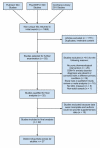Effect of pharmacotherapy for anxiety disorders on quality of life: a meta-analysis
- PMID: 24241771
- PMCID: PMC3966969
- DOI: 10.1007/s11136-013-0573-8
Effect of pharmacotherapy for anxiety disorders on quality of life: a meta-analysis
Abstract
Purpose: Pharmacotherapy is an effective treatment for anxiety disorders, but its effects on quality of life (QOL) have not been examined systematically. Our objective was to conduct an effect size analysis of pharmacological interventions on QOL outcomes in patients with DSM-IV anxiety disorders.
Methods: Manual and electronic searches using PubMed, PsycINFO, and the Cochrane Library were conducted for records from the first available date through May 1, 2013 for trials of pharmacological interventions in patients with anxiety disorders, which had measures of QOL before and after treatment. Of 1,865 entries, 93 studies were identified as potentially relevant and 32 met inclusion criteria, of which results were examined from 22 studies reporting 27 distinct pharmacological trials, representing data from 4,344 anxiety disorder patients. Data were extracted independently by multiple observers to estimate within-group and placebo-controlled random effects of the treatment changes on QOL. We hypothesized that pharmacotherapy improves QOL, which is associated with improvement in anxiety symptoms.
Results: Pharmacological interventions effectively improved QOL from before to after treatment (Hedges' g = 0.59), although the controlled effect size is smaller among those trials with placebo interventions (Hedges' g = 0.32). These effect sizes were robust, increased with publication year, and increased with reductions in anxiety symptoms.
Conclusions: Pharmacological therapy is effective for improving QOL in anxiety disorders, and larger symptom reductions are associated with greater improvement in QOL.
Figures
References
-
- DuPont RL, Rice DP, Miller LS, Shiraki SS, Rowland CR, Harwood HJ. Economic costs of anxiety disorders. Anxiety. 1996;2(4):167–172. - PubMed
-
- Cramer V, Torgersen S, Kringlen E. Quality of life and anxiety disorders: a population study. Journal of Nervous and Mental Disease. 2005;193(3):196–202. - PubMed
-
- Mendlowicz MV, Stein MB. Quality of life in individuals with anxiety disorders. American Journal of Psychiatry. 2000;157(5):669–682. - PubMed
-
- Olatunji BO, Cisler JM, Tolin DF. Quality of life in the anxiety disorders: a meta-analytic review. Clinical Psychology Review. 2007;27(5):572–581. Rapaport MH. - PubMed
Publication types
MeSH terms
Substances
Grants and funding
LinkOut - more resources
Full Text Sources
Other Literature Sources
Medical
Miscellaneous



